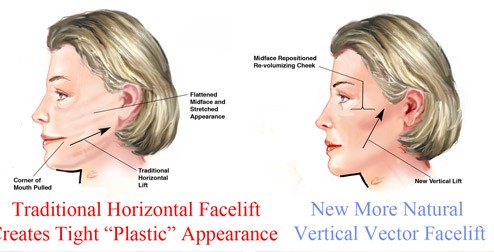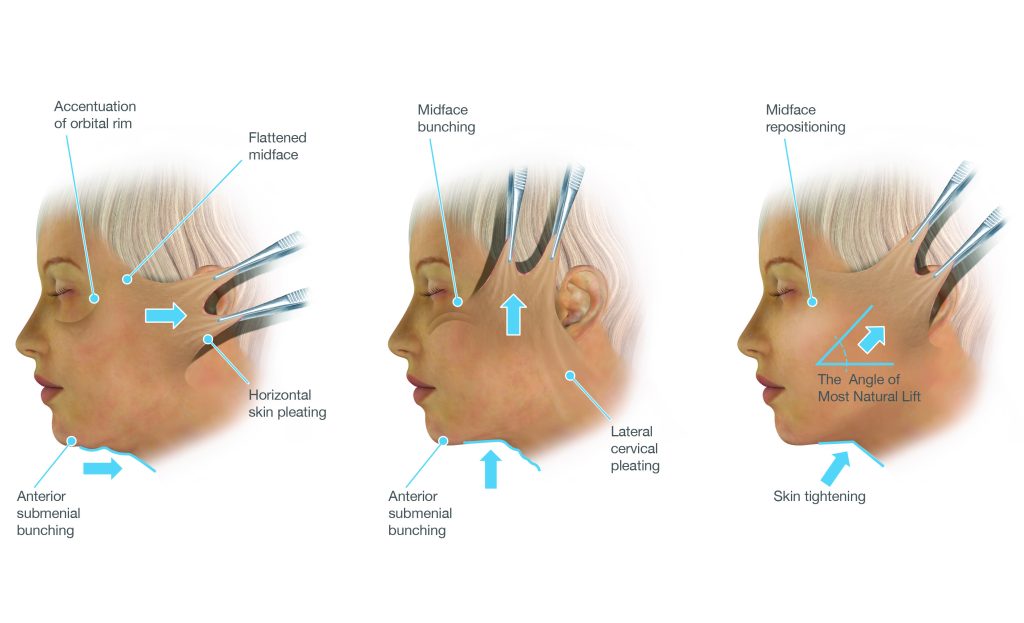Face Lift
Turn back time and treat yourself to a more youthful look
Your Face Lift Surgery Incudes:
- Hospital Stay In A Single Private Room + Theatre + Pathology
- Australian Client Manager
- Surgery + Plastic Surgeon + Anaesthetist + Nursing Fees + Hospital Fees
- Bandages, Dressings + Prescribed Medications for 7 Days
- Pre + Post Operative Consultations with Our Surgeon
- Zoom Calls + Photo Checkups with Surgeon for 12 months
- Airport, Hotel and Hospital Transfers Included

- Full Face Lift + Mid Face Lift + Neck Lift
- Brow Lift + Upper Face Lift
- Endoscopic Brow Lift with 2 Endotines
”I had a full face and neck lift with Dr. Teerapat and Medi Makeovers. The results are extraordinary.
SarahFull Face Lift With Neck Lift

Deep plane face lift
The facelift is an operation that can address some of the changes of ageing in a significant and permanent fashion. Unlike injectables, which can make the face appear full, paralysed or just unnatural, a well performed facelift can alter the face and neck in a natural manner.
The facelift operation has evolved significantly over time. Early facelifts were done by tightening skin alone. This can lead to a ‘tight’ appearance in the face that looked unnatural. The results also tended not to last for more than a couple of years. Further research determined that a more permanent and natural result could be obtained by tightening a deeper layer in the musculature of the face, known as the superficial muscular aponeurotic system or SMAS. The SMAS lift can obtain good results and is commonly practiced. The Deep Plane Facelift has been the next evolution.
Our Medi Makeovers Surgeons performed SMAS lift facelifts for many years before shifting to the deep plane facelift technique. They were impressed by the results as well as the improved recovery of patients with this technique.
The deep plane facelift lifts a layer of tissue which is fibrous and inelastic. Unlike the skin which is very elastic and has a tendency to re-stretch over time, the deep plane facelift is durable. Results should last 10 years or longer, longer than a traditional skin or SMAS lift. The deep plane facelift creates natural results and avoids the stigmata of tightness that can occur with other facelifting techniques.
Am I Good Candidate
A deep plane facelift can be done in both men and women. It can assist with changing a range of age-related changes in the face and neck. This includes jowls along the jawline, platysma vertical bands in the neck and other areas of descended skin and muscle around the midface and mouth. Patients should be in good physical health. During your FREE video consultation with our surgeons, they will explain the process and how this can suit you.
What is a Deep Plane Facelift?
The key distinguishing feature of a deep plane facelift is that it lifts only the muscle layer (the SMAS), leaving the overlying skin attached. This means that the skin never looks tight or unnatural. It also releases important tethering points in the cheek area and along the jawline. This allows the muscle layer to re-drape in a very smooth fashion under minimal tension. The addition of fat or filler is usually unnecessary.
The “deep plane” is a term used to define the tissue layer between the SMAS and the muscles of facial expression which lie deep to it. The muscles of facial expression are covered by a thick layer of fascia so are easily identified by a properly trained surgeon. The deep plane facelift releases the SMAS muscles with their attached skin and fat and repositions them. This avoids pulling on the skin or removing excessive amounts of skin.
Four ligament groups need to be released to allow adequate movement of the structures of the face and neck.
- The zygomatic ligaments connect the cheek skin to the underlying bones. In order to elevate the cheeks they need to be released. A youthful face can often appear “heart-shaped” with more volume in the upper part of the midthird compared to along the jawline. Once the zygomatic ligaments are released, tissue can be moved upwards to create this heart-shape. Additional filler, fat or cheek implants are not necessary. Releasing these ligaments also helps to elevate tissue into areas of hollowing under the eyes and lift the nasolabial folds.
- Mandibular retaining ligament. This ligament tethers the tissues along the jawline near the chin. When it is released lines around the chin as well as the anterior jawline are often improved.
- Masseteric cutaneous ligaments. These ligaments tether tissues along the angle of the jaw. Once they are released they allow the entire jawline to becomes smoother and tighter.
- Cervical retaining ligaments. The deep plane facelift is extended down into the neck to allow re-draping of the neck tissues in continuity with the facial tissues. This assists with creating changes that are long lasting. Traditional SMAS lifts can sometimes cause tissue to be bunched up around the back of the jawline. By lifting tissues back up into the face rather than at the back of the jaw this problem is avoided.

Vertical Lifting
Traditional facelifts often focused on stretching skin backwards towards the neck and ears. This sometimes gave the face a very stretched appearance. This type of lift can also flatten the cheeks. Even the corners of the eyes or the mouth would sometimes be pulled sideways. A deep plane facelift uses a vertical vector to lift tissues upwards rather than backwards. This creates a much more natural facial contour. The cheeks become volumised, corners of the mouth can be altered from downward pointing to slightly upward. The actual best angle that tissues need to be lifted tends to become more vertical as we age and needs to be customised to each patient.


Platysmaplasty (Neck Lift)
A deep plane facelift may need to be combined with a procedure in the midline of the neck called a platysmaplasty. The free edges of the platysma muscle often sag down into the neck creating two vertical lines an inch or so apart from the midline. A small incision may need to be made just under the chin to identify these muscle bands and suture them together. This creates a type of muscle sling that can be used to lift up any loose fat in the neck. The incision under the chin is very well hidden. In the majority of patients the deep plane facelift creates sufficient lift that a platysmaplasty is not necessary.
Image below depicts the underlying muscle bands of the platysma being sutured back together as a platysmaplasty

Deep Plane Facelift Recovery
You can expect bruising of some areas of the facial and neck skin for at least two to three weeks after a deep plane facelift. Swelling of the face occurs the morning after surgery and typically lasts longer than bruising. The swelling will be significantly improved by 2 weeks but will continue to decrease in size over around 6 weeks. If due to work or social commitments, you want almost no visible evidence of healing after a facelift, you may need to wait at least 6 weeks. Scars can stay a red colour for much longer before finally fading to white.
The bruising and swelling in the face from a deep plane facelift is less than with a standard SMAS facelift. This is because the deep plane technique is performed in a natural tissue plane layer that does not usually have many blood vessels within it. In addition, the attachments from the skin to the SMAS layer underneath it is left undisturbed for most of the face, again leading to less skin bruising and swelling. SMAS facelifts typically disrupt the attachments between the skin and SMAS.
Typically, patients feel little to no pain after surgery. Head elevation and cold compresses can be helpful to assist with reducing swelling.
You will be required to wear a facial compression garment during the first 2 weeks and then our surgeons will advise you the process from that stage, depending on your progress.
Deep Plane Facelift Scars
The deep plane facelift leaves the most hidden scars of any facelift surgery but they are never totally hidden. Since the tissues are lifted in a deep layer, little to no tension is placed on the skin. This allows the skin edges to heal close together with the best possible scars. Over 12 months, scars will appear as very fine lines, almost invisible. Another key benefit is that this technique can help prevent the earlobes from being pulled downwards which can create a deformity, although this risk is not totally removed.
Advantages of the Deep Plane Facelift
- More natural results by repositioning the SMAS and platysma layer
- Restoration of natural volume an elevation of the cheeks (no need for fat grafting or facial implants)
- Shorter recovery time
- Better scars
- Longer lasting result
- Improved nasolabial folds
- Smoother skin
Your Recovery + After Care
In general, the more extensive the facelift surgery, the longer the recovery period will be. Today, advances in techniques and technology have resulted in shorter recovery times following surgery of all kinds. Nevertheless, a recovery phase remains as crucial as ever to the success of any treatment. By following your surgeon’s explicit instructions, you can expect to experience the full benefits of your facelift.
After any type of facelift surgery, patients initially wear dressings that cover incisions as they heal. When the anesthesia wears off you may feel a bit nauseous or cold, but these feelings will typically subside quickly as the medication leaves your body. Usually, you will have bandages on your face, and there may be some drainage tubes as well, depending on the extent of the procedure. If you do have these tubes, you should expect drainage for at least 48 hours.
General risks of face lift surgery
Facelifts are common and typically successful procedures, but, like any surgery, they are not without risks. While facelift surgery can turn back the clock, correct sagging skin, tighten facial muscles, and improve your facial contour, it can also cause problems such as:
Bad Reaction to Anaesthesia
General anaesthesia can cause an unpleasant or unexpected reaction; however, a qualified anaesthesiologist should be able to identify emerging problems before they become worse.
Infection
Face lift patients are at risk of developing an infection during and immediately following their surgery. A clean, sterile, operating room lessens the risk of contracting an infection during the surgery.
After surgery, the risk of infection increases if the surgical wound is not properly cared for. Your surgeon will have specific instructions for removing/changing bandages, exposing your wound to water, and keeping it clean. Note that it is normal to have some bleeding and leakage after surgery, but if the surgical wound is unclean, the risk of infection rises. Most infections following face lift surgery are the result of the patient’s failure to properly care for their surgical wound during their recovery.
Slow Healing
Each patient will heal at his or her own pace. That being said, young patients in good physical condition typically heal faster than older or less physically fit patients. Tenderness, bruising, pain, and swelling usually subside after about four to six weeks. Patients who experience significant discomfort after six weeks have passed are considered to be healing slowly.
Smoking or exposure to cigarette smoke decreases the size of blood vessels, complicating circulation of oxygen to the skin cells.
Hematoma
Hematomas can be a serious problem. A collection of blood in a body cavity, a hematoma may cause pain, infections, scar tissue, or other issues. A sudden change in colour or contour of your skin is a warning that you may be developing a hematoma. Patients with this possible complication should contact their physician immediately so treatment can happen immediately.
Nerve Damage
In rare cases, a nerve may be cut, nicked, or cauterized, causing numbness or facial paralysis. Fortunately, when this does occur, the damage is not always permanent.
Temporary numbness
Some patents may experience a loss of sensation following their facelifts. While this can be a sign of nerve damage, it can also be a passing side effect that should resolve itself within a few weeks.
Visible Scarring
Although there will always be some scars remaining after a facelift, in most cases, they are hidden and over time will fade to a fine line. Occasionally, there may be some faint marks that are not concealed behind the ear or in the hair.
Client Testimonials
Types of Face Lift
If you are unsure about the procedures, you will need, please enquire, and our surgeons will give you a free assessment.
Full Face Lift
A full facelift combines elements of lower, mid, and upper facelifts. When an experienced surgeon with advanced knowledge of facial anatomy performs a full facelift, it can restore definition to your features, reduce wrinkling and sagging skin, and rejuvenate your appearance in a way that looks natural.
- This procedure also includes a Temporal Lift, the incision site is in the temporal area of the face along the hairline.
- Combining one or more treatments is more common for older patients who want a fully rejuvenated look.
- As always, patients should be prepared to discuss their goals with their surgeon, and they should expect the surgeon to thoroughly explain how different refinements will result in a harmonious overall enhancement.
- It is also possible to combine Eyelid Surgery with facelift surgery.
Neck Lift
A neck lift is a procedure that can provide a powerful complement to a mini facelift. Neck lifting tightens the skin of the neck and its underlying platysmal muscles, which extend from the chin down to the collar bones.
- Addresses everything visible from the neckline of a t-shirt to the lower third of the face.
- Neck lift surgery may be performed through a peri-auricular incision or separate incisions under the chin.
- In some cases, patients choose to incorporate liposuction into a neck lift to enhance the definition of their neck and jaw lines.
Mid Face Lift
A mid-facelift addresses the area that extends from the cheekbones to the jaw. Using incisions similar to those used in a mini facelift, the surgeon tightens the SMAS and skin tissue, pulling outward horizontally toward the ears to achieve a lift of two to four centimeters.
- Flattens folds around the mouth.
- The tissues are held in place with permanent sutures under the skin.
- Your surgeon can also redistribute the fat tissue in your cheeks to enhance your contours during this procedure.
- Once your skin and underlying tissues are redraped to achieve a natural-looking refinement, excess tissues are trimmed away, and the incisions are closed with sutures.
Brow Lift or Upper Face Lift
Forehead lift
A brow lift, also known as an upper facelift or forehead lift, reduces wrinkles and lines in the upper third of the face. Brow lift surgery subtly tightens the skin and underlying muscle tissue of the forehead, reducing wrinkles between the eyes and across the brow. It can also lift the eyebrows.
- Surgeons perform brow lift surgery using incisions created in the hairline, which result in subtle, easily concealed scars.
- The procedure is commonly combined with blepharoplasty or eyelid lift surgery. The combination of these surgeries can create a rejuvenated, more rested appearance.
- Our surgeons can offer an Indirect Brow Lift – this is where the incision site is approximately the length of your brows, but the actual incision site sits above your eyebrows but in the hairline. This procedure will give a forehead lift.
- A Direct Brow lift is when the incision site is directly above your eyebrows. This procedure will have no lift in your forehead.
Endoscopic Brow Lift with 2 Endotines
Endotine gives surgeons the ability to adjust your forehead-skin position through very small incisions behind your hairline, raising your brows to a natural position while softening creases between your eyebrows and along your forehead.
- Endotine lifts use small tines to securely hold your skin in just the right position.
- The tines are designed to reduce the strain and to pull associated with sutures.
- Endotine implants are made from a substance called polylactic acid, which is produced from plant materials.
- The result of an Endotine procedure is a more natural, revitalized appearance that doesn’t appear overdone or pulled.
- Endotine allows your surgeon to adjust the position of your skin during the procedure until it is just right.
What To Expect?
Once you have submitted your surgery medical form and photos – our team will arrange a free assessment, and outline all the details you will need to know about the Surgery Price, Length of Stay in Bangkok, Hotel, Transfers, and much more.
Payment Plans
Don’t have all the funds ready for your surgery or dental trip? Medi Makeovers have partnered with Australia’s leading financial service to offer our clients finance for all aspects of their medical holiday – even spending money.
TLC Credit Benefits
TLC provides a payment plan solution to suit your lifestyle and has been designed to cover all medical, cosmetic and lifestyle needs as well as your associated costs.
- Payment plans up to $50,000 – including treatment / flights & accommodation
- No stress – the whole process is managed privately by our Consultants
- Flexible options – any additional repayments can be added back on to the payment plan at no extra charge
- Fast efficient approvals, simply apply online
TLC offers a simple and personal solution to customers, where they personalise the experience to suit customer expectations and desires to ensure a smooth transaction. Finance can be arranged to cover not only the cost of overseas procedures, but also all associated travel costs including spending money.

Five Star Recovery
Bangkok is the perfect destination for your surgery and/or dental trip as most attractions, shopping malls and transportation are air conditioned and away from the warm climate of Thailand. This is particularly important for your post-op recovery after surgery. Our hotels are located in the best parts of town, away from the nightlife – yet close to all major shopping centres (you can walk to them!), massages, hair salons and beauty salons so you can have the best possible recovery and indulge a little!




